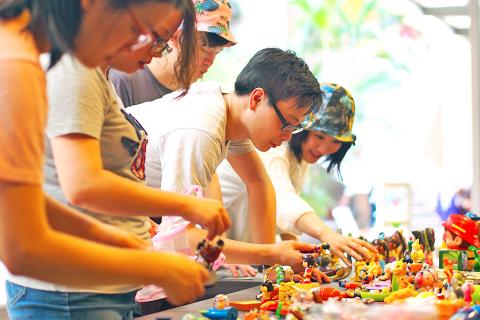Jim Chen (陳逸歆) was doing some spring cleaning last March when he discovered a bunch of old toys that he no longer had any use for. Before throwing them out, he decided to go online and check if his friends wanted them.
“Turns out, everyone had the same issue,” he said.
The friends lived quite far from each other, so they decided to find a central location to get together and exchange toys. Chen sent proposals to several venues, and the “Why the heck did I buy this?” (我怎麼會買了這種鬼東西) secondhand toy swap was born.

Photo courtesy of Li Shu-hung
Since then, Chen and friends have organized over 10 similar events around the country, each time drawing more interest. Four are planned this summer, with the Taipei one taking place Saturday and Sunday at Tuanyuan Dadaocheng (團圓大稻埕) from 2:30pm to 6:30pm. The swap continues in Taoyuan in August and Taidong in September.
While each person must bring at least one toy, Chen said there are no restrictions on era or type.
“I want to remind people to bring something that they think someone would want,” he said. “On the other hand, through these events I’ve found that many people are looking for items that have nostalgic value. You can’t say that something that has no meaning to one person wouldn’t for another. So, I don’t want too many restrictions.”
To add another dimension to the event, organizers are asking people to share their stories about why they picked a certain toy.
TOY STORY
“Someone wrote that he found a toy that his parents wouldn’t let him buy when he was a child,” Chen said. “Someone found a cherished toy that broke and was never replaced. I didn’t realize that this event was so meaningful to some people.”
In addition, the toy swap also partners with artisans and artists. During the spring events, there was an artisan on scene to repair damaged plush toys. This season they’re working with an artist who wants to use old toys to redecorate a coin-operated amusement park panda car. The artist will bring the car to the event for people to ride and collect toy donations.
Chen is surprised how word has spread. He’s been receiving requests to bring the toy swap to various locations in the country, but with regular jobs, the organizers can’t spread themselves too thin.
“When we finally made it to Kaohsiung, someone ran up to me and exclaimed, ‘We’ve been waiting for you for half a year. You’re finally here!’” he said.
While studying animation in the UK, Chen found it hard to clearly define Taiwanese culture.
“But with these toys, I discovered that they’re all part of our collective childhood memories,” he said. “Each time period and story is connected to toys. That makes one want to take this event seriously. I feel there are a lot of possibilities.”
The toy swaps run until the end of fall. In the winter, Chen plans to recap the year through activities like giving the leftover toys to people in need and creating an exhibition featuring the collected stories.
Visit www.facebook.com/2ndhandtoyswap for more information.

In the March 9 edition of the Taipei Times a piece by Ninon Godefroy ran with the headine “The quiet, gentle rhythm of Taiwan.” It started with the line “Taiwan is a small, humble place. There is no Eiffel Tower, no pyramids — no singular attraction that draws the world’s attention.” I laughed out loud at that. This was out of no disrespect for the author or the piece, which made some interesting analogies and good points about how both Din Tai Fung’s and Taiwan Semiconductor Manufacturing Co’s (TSMC, 台積電) meticulous attention to detail and quality are not quite up to

April 21 to April 27 Hsieh Er’s (謝娥) political fortunes were rising fast after she got out of jail and joined the Chinese Nationalist Party (KMT) in December 1945. Not only did she hold key positions in various committees, she was elected the only woman on the Taipei City Council and headed to Nanjing in 1946 as the sole Taiwanese female representative to the National Constituent Assembly. With the support of first lady Soong May-ling (宋美齡), she started the Taipei Women’s Association and Taiwan Provincial Women’s Association, where she

Chinese Nationalist Party (KMT) Chairman Eric Chu (朱立倫) hatched a bold plan to charge forward and seize the initiative when he held a protest in front of the Taipei City Prosecutors’ Office. Though risky, because illegal, its success would help tackle at least six problems facing both himself and the KMT. What he did not see coming was Taipei Mayor Chiang Wan-an (將萬安) tripping him up out of the gate. In spite of Chu being the most consequential and successful KMT chairman since the early 2010s — arguably saving the party from financial ruin and restoring its electoral viability —

It is one of the more remarkable facts of Taiwan history that it was never occupied or claimed by any of the numerous kingdoms of southern China — Han or otherwise — that lay just across the water from it. None of their brilliant ministers ever discovered that Taiwan was a “core interest” of the state whose annexation was “inevitable.” As Paul Kua notes in an excellent monograph laying out how the Portuguese gave Taiwan the name “Formosa,” the first Europeans to express an interest in occupying Taiwan were the Spanish. Tonio Andrade in his seminal work, How Taiwan Became Chinese,